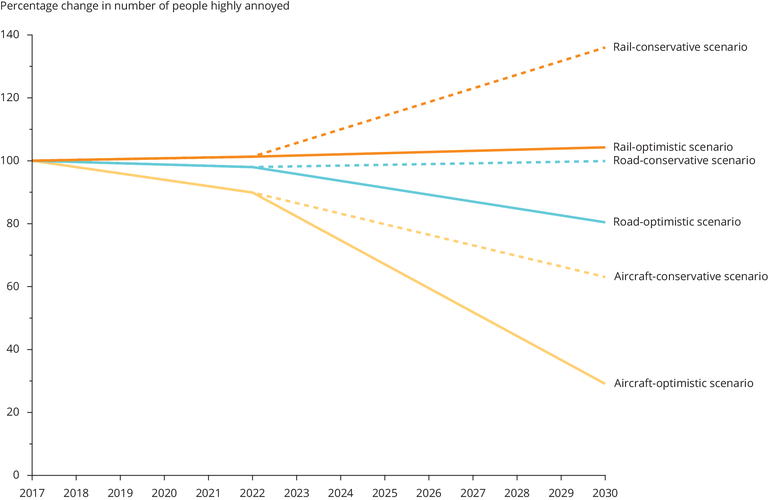All official European Union website addresses are in the europa.eu domain.
See all EU institutions and bodiesProjected percentage change from 2017 to 2030 in the number of people highly annoyed by noise from rail, road and aircraft under a conservative and an optimistic scenarios in EU-27
Chart (static)

High annoyance is based on functions outlined in the World Health Organization environmental noise guidelines (WHO Europe, 2018) and the number of people exposed to noise levels above 55dB during the day-evening-night period (Lden) because of road, rail and aircraft noise in areas covered by the Environmental Noise Directive.
The projections are based on different hypotheses, assumptions and approximations, each of which has associated uncertainties. The projections assume uniform implementation of the measures in all countries. The potential for reduction in each country depends on how many actions/measures have already been implemented. A decrease in noise levels due to the noise reduction measures is assumed to result in an annoyance decrease of at least that predicted by the WHO exposure-response relationship.
- Austria
- Belgium
- Bulgaria
- Croatia
- Cyprus
- Czechia
- Denmark
- Estonia
- Finland
- France
- Germany
- Greece
- Hungary
- Ireland
- Italy
- Latvia
- Lithuania
- Luxembourg
- Malta
- Netherlands
- Poland
- Portugal
- Romania
- Slovakia
- Slovenia
- Spain
- Sweden
Methodology
The full methodology is described in “Projected health impacts from transportation noise-Exploring two scenarios for 2030” published by ETC/HE (2022). https://www.eionet.europa.eu/etcs/etc-he/products/etc-he-products/etc-he-reports/etc-he-report-2022-5-projected-health-impacts-from-transportation-noise-2013-exploring-two-scenarios-for-2030
Additional information
- The dataset covers population exposed in EU-27 to noise sources such as roads with more than 3 million vehicle passages a year, railways with more than 30,000 train passages per year and airports with more than 50,000 aircraft movements per year, as well as all roads, railways and airports in urban areas with more than 100,000 inhabitants
- High annoyance is based on functions outlined in the WHO Environmental Noise Guidelines (WHO Europe, 2018) and number of adults exposed to noise levels above 55 dB Lden due to road, rail and aircraft noise in areas covered by the END
- The projections are based on different hypotheses, assumptions and approximations, each of which has associated uncertainties. The projections assume uniform implementation of the measures in all countries. A decrease in noise levels due to the noise reduction measures is assumed to result in an annoyance decrease of at least that predicted by the WHO exposure-response relationship.
- The full methodology is described in “Projected health impacts from transportation noise-Exploring two scenarios for 2030” published by ETC/HE (2022)
